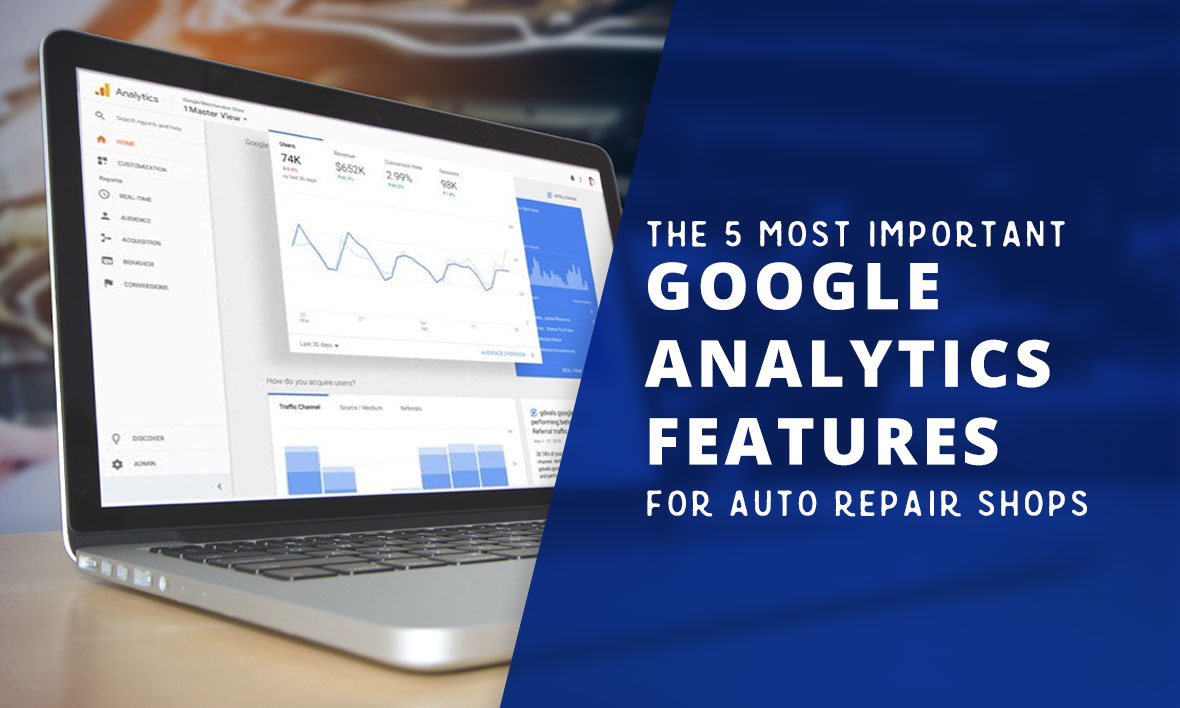For auto repair shops, your website is usually the most important piece of your marketing. Your website serves as the hub of all of your online marketing, and it’s involved in your traditional marketing as well if you’re a savvy marketer.
But how do you know if your website is performing for you? The answer is to look at your Google Analytics. Google Analytics is a free tool that will give you a behind-the-scenes look at what is happening on your website. As we tell you in our Ultimate Guide to Auto Repair Shop Marketing, Google Analytics is a must-have tool on your auto repair shop’s website.
When most people look at their Google Analytics or “webstats”, they look at the number of visits they’ve had in the last 30 days and they stop there. Traffic is important, but it doesn’t tell the whole story, and there’s not much you can do with that number once you have it.
If you take the time to become proficient at reading Google Analytics for your auto repair shop’s website, you can make changes to your website and your marketing that will positively impact your shop’s bottom line.
Below I’m going to give you 5 features you should start looking at to improve the way your auto repair shop’s website performs.
- Bounce Rate – The bounce rate is the number of users, by percentage, who leave your website having viewed only the page they entered on. For example, they search Google for “front end alignments” and they land on the “4 Wheel Alignments” page of your website. When they get there, the page is confusing, hard to read, or just doesn’t give a good user experience – so they leave your website. This is a bounce. Had they clicked through to an additional page during that visit, it would not have been a bounce.
As a marketer, you want to make your bounce rate as low as you can get it. When people spend time on your website viewing multiple pages, they’re interested in your business. The more time you can get people to spend on your website, and the more pages you can get them to view, the more likely they will become a client of your auto repair shop. You’ll lower your bounce rate by improving your overall user experience.
Please understand, not all bounces are a bad thing. If you create a great user experience and put information where people are able to easily find it, you may actually cause bounces to be registered. This is ok. For example, a client needs your phone number so they type in your web address or click on a search result. You’ve made your phone number super easy to find by putting it in the header of every page. They find the phone number, call you, and navigate away from your website. This is a bounce, but it is also a success because you gave the client what they were looking for in a single click.
- Site Content – The site content information is located in the “Behavior” section of Google Analytics. In this section, you can find out which pages of your website your users are visiting the most. This can give you key insight into what people are looking for that is driving them to your website. If you find that a lot of people are visiting the “Diesel Truck Service” page of your website, and if you want more of that type of work, you may want to spend some time building out the content of this page even more. You may even want to make this page a pillar page and build out some cluster topic pages for Powerstroke, Duramax, and Cummins Diesel repairs.
Looking at your site content to see which of your blog topics are getting the most views can tell you what type of blog posts work the best for you, and what other topics you should write about. For example, if your blog posts that are written as case studies are getting a lot more views than your blog posts that are more generic in nature, write more case studies.
- Acquisition Overview – The acquisition overview will tell you how people are getting to your website. It is broken down into 5 main categories that include direct, referral, social, search, and paid.
- Direct traffic is when someone inputs your domain name into the browser to go directly to your website.
- Referral traffic is when another website or online entity links to your website and someone follows that link.
- Social is simply traffic that is driven to your website from a social media site such as Facebook, Twitter, LinkedIn, Pinterest, etc.
- Search is traffic that was sent to your website from a search engine. Someone performed a search, your website was one of the search results, and your website was selected.
- Paid is traffic that you buy through Google AdWords, Bing, or some other network.
When you are looking at the acquisition overview, you can click into each of the categories and see in more detail where the traffic is coming from.
This information is a powerful, easy way to see what channels are working best for you in driving traffic to your website. If you’re investing a lot in Google AdWords, but you don’t see the results in your acquisition overview, something is wrong that needs to be fixed. Or if you’re seeing a lot of traffic coming from social, this may be a place you should decide to double down.
Just make sure you don’t stop with the overview numbers. Dig in and figure out how much of this traffic is actually turning into clients for your auto repair shop. Traffic doesn’t necessarily equal paying customers.
- Demographics – The demographics information is found in the audience section of your Google Analytics. This section will include information such as age, gender, geographic location, and language.
The most important information for most auto repair shops will be the age and gender demographics. This will allow you to tailor your marketing to the people who your shop and marketing are automatically attracting, or it will allow you to make adjustments to attract the demographics you want to see in your shop.
If your audience is primarily women between the ages of 24 and 35, you’ll want to consider things like having a children’s play area in your waiting room. If your audience is more men between the ages of 40 and 55, you may want to pull more of the hot rod influence into your marketing. You’ll need to make these determinations based on the area you serve. The way you market to a certain age and gender in New York City will be different from how you’d market to that same demographic in Bowling Green, Kentucky.
- Visitors Flow – The visitor’s flow is one of my favorite things to look at in Google Analytics. It’s a very cool flow-chart that shows you how people navigate through your website. You can click into each segment and highlight traffic through that segment. The red waterfall from each of the segments shows people leaving your website.
What this means for you is you can see which pages of your website you are losing the most visitors from. This can help you to improve your website content to keep people on your website longer. If you have a page with an abnormal amount of dropoffs occurring, try to make that page better. Place some internal links on that page to direct people to the part of your website you want people to visit most.
The thing I like most about looking at the visitor’s flow is it gives me a peek into the mind of my website’s visitors. I get to see how they think and what they are looking for the most. For the majority of auto repair websites, most people will enter on the homepage, navigate to the services page, and then to the contact or appointment page. See if you can break the norm and take people on a different journey when it makes sense. The visitor’s flow will be your eyes into your success.
The purpose of this article is to get you to dive deeper into Google Analytics and begin diagnosing your website’s performance just as you would a car in your shop. Dig in, be curious, and have fun. Most of all, don’t just take my word for these being the most important features. Go find the ones that mean the most to you in your auto repair shop, then come back and share with us how you’re using this awesome tool!

About The Author



